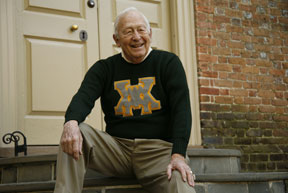William and Mary spirit: It is not about logos says Kelly
 Related content
Related content
Jim Kelly audio excerpts: It's not insignia, it's pride / Envisioning creation of the first logo.
Today, William and Mary students and alumni bleed green and gold—but that wasn’t always the case. The school’s first colors were actually orange and white.
Like green, gold and silver, all of the other school colors stem from the College’s history—orange from William of Orange, white from the white rose of York, black also from the orange and black colors from the House of Nassau in King William’s lineage.
University Archives show that orange and white blazoned William and Mary football jerseys as early as 1894. Those colors rang true until the 1911 football season when orange and black colors were revealed. A Colonial Echo from the period notes that the white was dropped because the orange ran too easily on the white jerseys in the laundry.
When the College’s coat-of-arms was rediscovered in the early 1900’s the jersey colors were changed once again. By the 1924 season the team was sporting the green, gold and silver colors from the seal in the coat-of-arms.
Still, green and gold seemed to have lasted the longest.
“Dean Lambert told me,” reminisced William and Mary alumnus Jim Kelly. “‘The College did not have but one color—that was green, gold and silver were metals.’”
Tribe Pride and the mascots
Kelly (’51) noted his letter sweaters were embellished with a cipher—the “W” and “M” of William and Mary one over the other and slightly interlocking.
“My letter sweater has the cipher on it—which I like very much. I’ve got three letter sweaters, as a matter of fact, which I’m very found of, very proud of.”
In fact, Kelly said, of all the William and Mary memorabilia he owns, his favorite pieces are the sweaters. It isn’t because of their color, or because of the classic cipher, he says. It’s because they represent William and Mary.
During his undergraduate years at the College, Kelly said of the school’s mascot, “As much as anything we were the Indians … . The first time we see anything about Indians in the yearbooks is in 1914-1915 and we’ve got ‘The Brafferton Indians’—it was a club on campus.”
With this name came an Indian mascot, a caricature figure known as Wampee that was used well into the 1970s. Wampee was introduced by Les Hooker.
“Les Hooker, was the director of athletics, he had been the basketball coach” noted Kelly, “… he went out and got Wampee. Wampee looked exactly like the Cleveland mascot—in fact I think he used the Cleveland mascot—it was a big Indian head that went bouncing around the field.
“William and Mary alumni and William and Mary students, they are full of fun but if something is ridiculous then it just doesn’t last and Wampee was kind of ridiculous,” continued Kelly. “So, Wampee disappeared.”
After Wampee came Wampo and the Wampo II, the pony mascots.
“Keeping a horse when there are no stables and it’s a pony is very difficult,” said Kelly. “So after a couple of seasons and Smith (the rider) graduated, Wampo kind of faded from the scene … . He also kind of tore up the football field.”
Some years later, Kelly noted, Wampo was followed with Wampo II. But he didn’t last either.
University Archives also contain references to several unofficial nicknames ,including the Big Green Tribe, Big Green, Warriors, Fighting Indians and Braves.
“We went up to play Harvard [in the mid-1920s] and we tied them 13 -13, and the Boston papers described William and Mary … as the ‘Fighting Virginias,’ recounted Kelly. “That was sort of unofficial. … When the football team ceased to win we weren’t the ‘Fighting Virginias’ anymore.”
Then came The Tribe, which first appeared in the 1924 edition of the Colonial Echo.
“[The Tribe] evolved as so many things do” Kelly said. “It was acceptable. It seemed right to the students and it seemed right to the alumni and the faculty didn’t particularly have an opinion, which leads to the most generally accepted thing you would get.”
“Tribe is a good name. It’s a community of like thinking people and the feathers were just a nice little touch.”
Plucked!
Following a ruling by the National Collegiate Athletic Association in 2006 that deemed the athletic logo with feathers impermissibly “hostile and abusive,” the College announced it would begin the process of developing a new logo. A committee of alumni, faculty, staff and students helped develop an updated logo for the College, which was unveiled Dec. 6. As Kelly, who served on that committee noted however, no matter what emblem is chosen, William and Mary will always be William and Mary.
“It’s not insignia and it’s not logo, I think truly it’s the spirit of William and Mary and I don’t think that is ever going to be captured in anything but the in hearts of the people who have been here and had this very special experience.”
It’s all about Tribe Pride.
The facts and information in this story came from information provided by University Archives, a personal interview with Jim Kelly (’54) and member of the logo redesign committee and from the book Goal to Goal by Kale, Moskowitz and Holloway.
 Skip to main content
Skip to main content
